
 Question:
Question:I teach first grade. I find that by the end of Morning Meeting, my students tend to be fidgety and restless, so I’ve been taking them out for recess after meeting and before starting the rest of the day. That seems to help them. They come back in more settled and ready to get to work. My principal, however, has said that this isn’t a productive use of time. What do you think? Do you have any information on what time of day is best for recess?
Your idea of offering your students more physical activity after you have stretched their mental capacities is a good one. However, within the meeting, there are ways to provide more physical activity and a structured transition to the rest of the day without going outside. This would allow you to save your outdoor breaks for mid-morning and afternoon when children really need a change of pace.
Part of good teaching is the ability to “read” our groups and modify our strategies accordingly. It sometimes does take a while for children to be able to stay focused through all the components of Morning Meeting. Many teachers adapt or shorten meetings to meet the needs of the group and still stretch the children’s ability to concentrate and participate. After all, Morning Meeting is a method we use to deliberately strengthen students’ impulse controls and social skills. We expect—and are teaching—children to manage themselves while attending to others. We expect them to listen, ask questions, take turns, stay in their spaces, raise their hands, and not call out. We expect moments of playful participation and moments of serious attention and sharing. And while it is not unusual to see some children begin to squirm and lose focus as Morning Meeting progresses, we very much want the meeting to be a successful experience, to set a positive tone for the day.
Clearly these expectations can be a challenge for first graders, many of whom may only be five and a half, may need a lot of physical activity, and may tire quickly. Thus we strike that artful balance between stretching students’ abilities and being realistic about their limits. Below are some ideas for incorporating more physical activity into each component of Morning Meeting as a way to find that balance:
If it’s hard for children to go around the circle and do a handshake greeting or other quiet greeting without hesitating or dragging it out, try more active and participatory greetings most days. Some groups do much better with chants and gesture-filled songs, singing out each other’s names and acting out playful motions. Here are just two such greetings:
The whole class repeats the following chant until each child in the circle gets a chance to say his/her name.
Hickety-Pickety Bumble Bee.
Won’t you say your name for me.
_______________ (Child being greeted says his/her name.)
Let’s all say it. (Group says the child’s name.)
Let’s clap it, too. (Group says name and claps out the syllables.)
Let’s whisper it. (Group whispers the name.)
Let’s turn off our voices and clap it. (Group claps out the syllables without speaking.)
This greeting can be sung or chanted. When a child’s name is called, the child comes into the middle of the circle and does a movement of her/his own choosing—for example, a bow, curtsy, wave, dance, wiggle, etc. During the last line of the song, the child moves back to her/his place in the circle. Another child’s name is called, and so on around the circle.
One, two, three, four! Come on, ____________, hit the floor.
We’re so glad you’re here today.
Hurray, hurray, hurray!
Sharing is a wonderful way for children to get to know each other, to show interest and to develop the vocabulary for noticing and conversation. But doing this well takes practice for both speakers and audience. Here are some ways to help enliven this part of the meeting and pace it to the needs of the group:
Again, I tend to choose Morning Meeting activities based on the needs and day-to-day moods of the group. Activities that involve pantomime and motion can help harness and channel restless energy. I am always struck by how much children love fast-paced games that involve quick ups and downs and ins and outs, but also require them to pay attention. Here are two activities that fit this description:
Everyone sings the song “My Bonny Lies Over the Ocean.” Whenever words beginning with a “b” are sung, children alternate between sitting and standing. For example: “My Bonny (stand) lies over the ocean. My Bonny (sit) lies over the sea . . .”
The words to the song are:
My Bonny lies over the ocean.
My Bonny lies over the sea.
My Bonny lies over the ocean,
So bring back my Bonny to me.
Bring back, bring back,
Oh bring back my Bonny to me, to me.
Bring back, bring back,
Oh bring back my Bonny to me.
One student begins the game by pantomiming some simple action in the center of the circle, such as brushing his/her hair. The next student in the circle approaches the hair-brusher and asks, “What are you doing?” The hair-brusher responds by saying something completely different, such as “I’m washing the floor.” The student who asked now pretends to wash the floor. The next student then comes to ask the floor-washer, “What are you doing?” This goes on until everyone in the circle has had a chance to pantomime an action.
Closing the meeting with the News and Announcements chart gives children a way to settle and refocus. To be of real interest, the message has to change daily and be specific to the day and class. It also has to be read in a way that’s suitable for the age, attention span, and energy level of the particular group. After a rousing Morning Meeting activity, one class of first graders quickly returned to the chart when the teacher covered a single word and asked, “Who thinks they know what word I’m covering? I’ll give you a hint. It is about something we will do today.” Eyes became centered, hands went up, and the day was at hand.
Ruth Sidney Charney has taught children and teachers for almost 30 years. She is the author of Teaching Children to Care and Habits of Goodness.